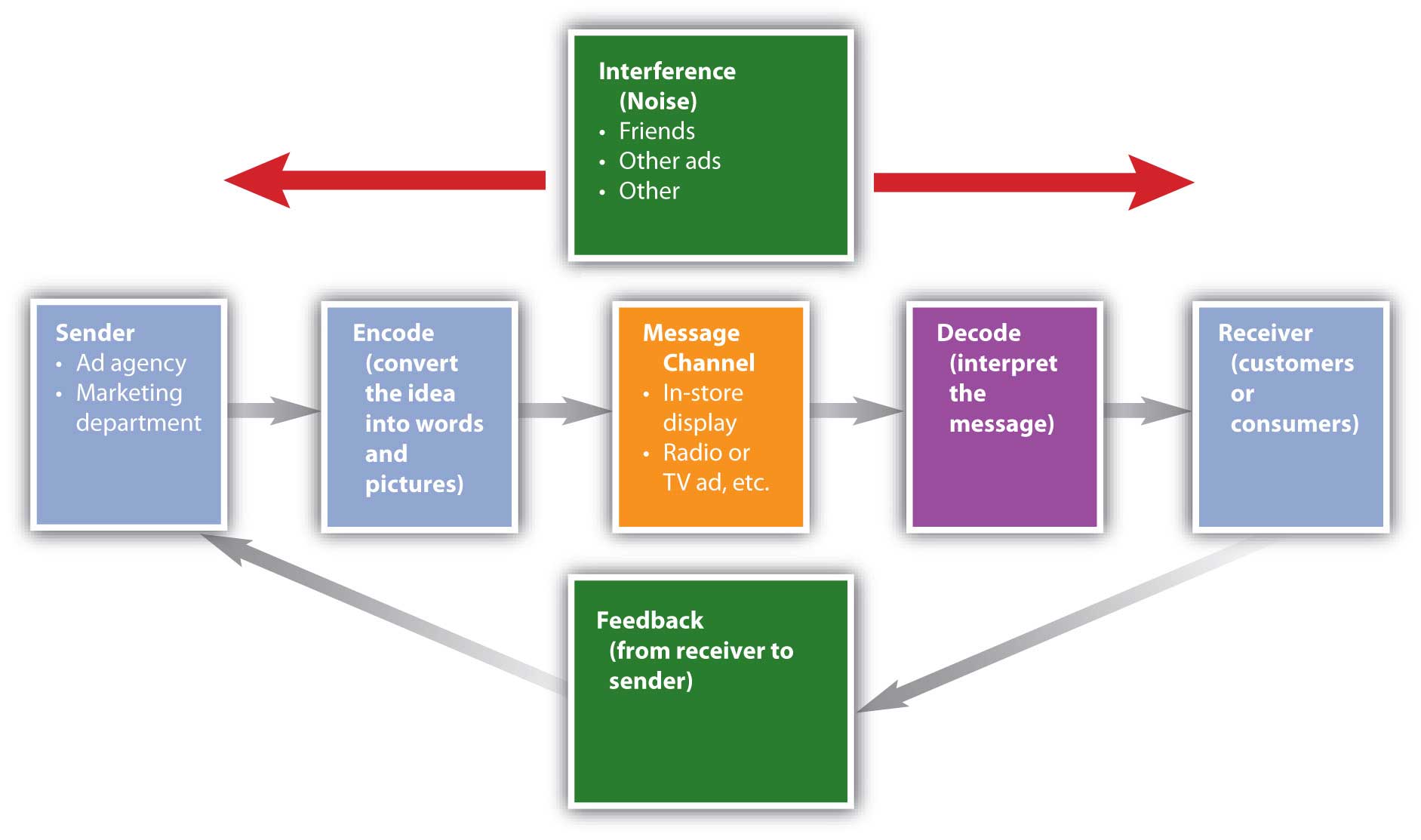Chapter 10: Promotion (Integrated Marketing Communications)
10.1 Communication Process and Message Problems
Learning Objectives
- Know the communication process.
- Understand encoding and decoding.
The Communication Process
Think about which television shows you choose to watch, which magazines you read, and which radio stations you select. The perceptual process is how a person decides what to pay attention to and how to interpret and remember different things, including information in advertising. By selecting a magazine, a television show, or even an elective class in school, you’re selecting what you’re exposed to and deciding what gets your attention. However, your selection does not ensure you’ll either pay attention or remember or correctly interpret what you see or hear.
Think about what else you are doing when you watch television, when you are studying, or when you are listening to the radio. It’s a hot day in July, and you’re enjoying a day at the beach. Your friends brought a speaker, and the volume is turned up so you can clearly hear the music. If you’re listening to the music or talking to a friend at the beach while you’re listening to the radio, do you hear or pay attention to the commercials? Do you remember which products were advertised? If you’re with a friend and hear someone else say your name, do you pay more attention to the person talking about you than to your friend?
The same thing happens when you are watching a show, reading a magazine, or studying for a test. A notification appears on your phone or your friends show up and your attention shifts to them. With so many different types of distractions and technology, imagine how difficult it is for an advertiser to get you to pay attention much less remember the message. Do you remember the terms you memorized for a test a day later? Do you know your friends’ phone numbers and e-mail addresses, or do you just find their names on your contact list? To increase retention, advertisers may repeat the same message multiple times in different places, but they must be careful that consumers don’t get so tired of the message that there is a negative effect.
The communication process illustrates how messages are sent and received, as shown in figure 10.1. The source (or sender) encodes, or translates, a message so that it’s appropriate for the message channel—say, for a print advertisement, TV commercial, or store display—and shows the benefits and value of the offering. The receiver (customer or consumer) then decodes, or interprets, the message. For effective communication to occur, the receiver must interpret the message as the sender intended.
Message Problems
You’re ready to go home on a Friday afternoon, and you hear someone mention an upcoming event on Saturday. However, you did not listen to all the details and assume the event is the next day, not the following Saturday. Since you already made other plans for the next day, you don’t even consider showing up the following Saturday. Has this ever happened to you? You didn’t show up at an event because you didn’t interpret the message correctly? If you do not hear someone correctly, misread information, or misinterpret a message, you might think a product or service provides different benefits or is easier or harder to use than it really is.
Interference, or noise, can distort marketing messages. Factors such as poor reception, poor print quality, problems with a server, or a low battery can interfere with messages getting through. Interference includes any distractions receivers and senders face during the transmission of a message. For example, if you’re studying for an exam while talking on the phone, the conversation may interfere with your ability to remember what you’re reading. If a friend tells you a story, then you tell another friend, and that person tells someone else, will the message be the same after it is relayed to multiple people? If you miss class and borrow someone else’s notes, will you understand what they mean? Not only must advertisers try to present consistent messages, they must also try to ensure that you interpret the message as they intended.
Purchasing a product provides the sender with feedback, which often tells the seller that you saw information and wanted to try the product. If you use any coupons or promotions when you buy a product, the advertiser knows which vehicle you used to get the information. Market research and warranty registration also provide feedback.
We tend to purchase products and remember information that has some relevance to our personal situation or beliefs. If you have no need for a product or service, you might not pay attention to or remember the messages used to market it. Advertisers also want you to remember their brands so that you’ll think of their products/services when you need to make a purchase.

Key Takeaways
Many factors, such as a firm’s marketing budget, the type of product, regulations, target customers, and competitors, influence what composes the promotion mix. Depending on what medium is used, marketers use the communication process to encode or translate ideas into messages that can be correctly interpreted (decoded) by buyers. However, marketers must determine how to get consumers’ attention and avoid as much interference and noise as possible. Perceptual processes include how a person decides what to pay attention to and how to interpret and remember different things.
Review Question
- Explain the communication process and factors that can interfere with interpretation of messages.
- What is the perceptual process and how does it relate to promotion?
- What is the difference between encoding and decoding a message?
how a person decides what to pay attention to and how to interpret and remember different things
translating a message so that it’s appropriate for the message channel
the receiver (customer or consumer) interpreting the message
interference that distorts marketing messages
information the seller receives by someone purchasing a product

